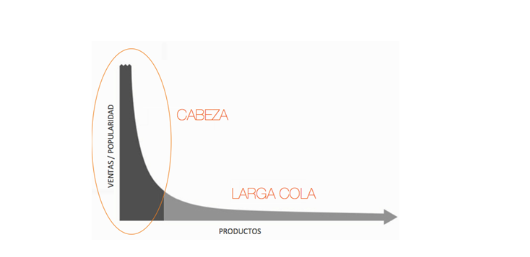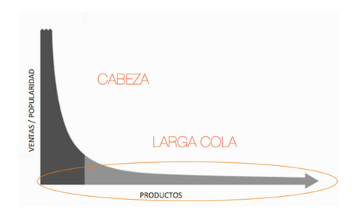SPECIALISATION OR NICHE STRATEGIES
Accelerate your business with these expert tips on "Specialisation or niche strategies". Analyse and discover this TIP!
The specialisation or niche strategy is a type of generic strategy that is very useful for competing in a sector. It is highly recommended at the beginning to focus and concentrate efforts on only one sector. customer segment.
Diversification or specialisation?
At the beginning of your new business it is better to specialise, to focus on satisfying only one customer segment. It is a kind of generic strategy. It seems to have risksIt forces you to say "no" to other customers, but it is better to focus and concentrate your efforts to begin with. Niche businesses grow much faster than generic ones. Going for everything and nothing is the same thing. Many companies keep trying to be everything to everyone when in reality this makes them nothing to no one. You have to courageously take on the challenge of focusing on a much smaller market but one in which you can also become the player by dominating the leader and even stop competing on price. In order to define the right strategy for your new company (differentiation, cost leadership or specialisation) we recommend a acceleration week (see+) living with more projects that allow you to get to know all the options.
Specialisation strategies are those that focus on offering specialised, high quality products or services to a specific market segment. Rather than trying to compete in a broad market, companies that adopt a specialisation strategy focus on a smaller, more focused part of the market.
Some examples of specialisation strategies:
- Specialisation in a niche market: This is a strategy in which a company specialises in a very specific and highly specialised market segment. For example, a company may specialise in the production of high-tech medical equipment for the healthcare industry.
- Product specialisation: A company that specialises in a single product and does it exceptionally well can be very successful. This approach allows the company to focus on product quality and innovation.
- Specialisation in a technology: Some companies specialise in a specific technology and develop products and services that use that technology exclusively.
- Specialisation in a process: process specialisation focuses on doing a specific process more efficiently and effectively than the competition. A company that specialises in car manufacturing, for example, may have a highly efficient production process that allows it to produce vehicles at a lower cost than the competition.
Specialisation strategies are very effective for companies that have a clear understanding of their target market and can offer high quality products or services to that market. These strategies can also be useful for companies seeking to differentiate themselves from the competition and build a strong brand.
Advice to an entrepreneur on how to leverage specialisation strategy for lasting competitive advantage
Specialisation strategy is one of the ways to gain competitive advantage in the market, by concentrating on a specific market segment or offering a highly specialised product or service.
THE FOLLOWING ARE SOME TIPS ON HOW TO TAKE ADVANTAGE OF THIS STRATEGY:
- Identify your niche market: Specialisation is based on identifying and targeting a specific market segment. It identifies the unmet needs and demands of customers in a specific niche and tailors your products and services to those needs.
- Offer unique products or services: To be successful in specialisation, you must offer unique products or services that meet the specific needs of your customers. This may require innovation, research and development to create products or services that are not currently available on the market.
- Build strong relationships with your customers: specialisation allows you to develop a deep understanding of your customers' needs and build strong relationships with them. Leverage these relationships to get feedback on your products or services and make adjustments accordingly.
- Create a strong brand: specialisation allows you to build a strong brand in your niche market. Develop a brand identity that reflects your unique products or services and connects with your customers in a meaningful way.
- Keep a constant focus on quality: specialisation requires constant attention to the quality of your products or services. Maintain a high level of quality in everything you do and make sure it aligns with the needs and expectations of your customers.
- Maintain your competitive edge: Specialisation can be a lasting competitive advantage if you keep your focus on your niche market and keep innovating and improving your products or services. Keep an eye on the market and adjust your strategy if necessary.
- Build alliances with other specialists: seek alliances with other companies specialising in complementary areas to enhance your offer and broaden your reach. These alliances can allow you to access new markets and increase your competitive advantage.
Remember that the specialisation strategy is not suitable for all companies, so it is important to carefully assess your capabilities, resources and the market before deciding to adopt this strategy.
HOW DO LONG TAIL BUSINESS MODELS WORK?
The concept of "long tail" refers to a business strategy that focuses on serving smaller, more specific niche markets rather than concentrating on the mass market. This strategy is based on the idea that the sum of sales of niche products can be equal to or greater than the sales of popular or mass products.
SOME TIPS FOR LEVERAGING A NICHE STRATEGY AND CREATING A LASTING COMPETITIVE ADVANTAGE ARE:
- Identify a market niche that is underserved or has an unmet need.
- Offer high quality products or services customised to the needs of the niche.
- Establish a strong brand that is associated with the niche market.
- Foster an online or offline community of customers who share similar interests and needs.
- To offer a unique shopping and customer service experience that fosters loyalty.
- Leverage digital technologies and tools to reach niche markets effectively.
- Seek partnerships with other companies or brands that share similar interests or values.
- Continuously measure and analyse business performance to adjust and improve the niche strategy.
The niche or "long tail" strategy can be an effective way to create a lasting competitive advantage by targeting a specific market segment and offering high quality, customised products or services. We have been taught to focus our attention on mass markets, on being able to create and sell a few products that have the potential to generate a lot of demand... which makes us discard products or services with lower demand to focus on the top-sellers... but is that still valid today?
WHAT IS A "LONG TAIL" BUSINESS MODEL?
It is a concept coined by Chris Anderson in his article The Long Tail, which later became the book The Long Tail Economy (and even a TED talk). Its origins are based on a simple idea, and that is that we have traditionally designed all business models around the Pareto rule: 20% of products will generate 80% of sales. In other words, let's focus our efforts on mass markets, on selling even more of the products that are in high demand.
IF WE PLOT THE SALES DISTRIBUTION OF ANY COMPANY ON A GRAPH, IT WILL PROBABLY LOOK LIKE THIS:

- HEAD: These are the most popular products, the ones most commonly ordered by customers... the top sellers, the Top 40. As the English say, the mainstream.
- COLA: This is a very diverse range of products that although they DO have a demand, it is much lower than in the case of the head... and they are usually discarded.
And what does business strategy tell us? So it seems obvious that we should focus our efforts on the head of the queue, which is where it makes the most sense to invest our resources in order to sell more.
LET'S USE AN EXAMPLE TO HELP US UNDERSTAND THIS:
"Imagine you have a 100m2 bookshop. Which books would you put on the shelves, the ones most in demand by the public ("Fifty Shades of Grey"...and so on) or books that sell less, even if from time to time someone asks for them ("The reproduction of the Peruvian male beetle")". The answer is obvious, and it is based on the fact that there is a scarce resource, in this case physical storage space, which we want to use with products that generate maximum profitability. Absolutely sensible.
However, in recent times, new models have emerged, called 'Long Tail', which base their effectiveness on selling fewer units of more things (in other words, focusing on selling a greater number of products (the 80%) with a lower volume of sales). This is because consumers increasingly prefer niche products or services that are more specific and better meet their needs than generalist products. That is to say: long tail models allow the creation of new business models for niche products or services by aggregating low demand... in other words, unleashing the potential of businesses outside the mainstream.

ARE LONG TAIL MODELS REALLY NEW?
Not at all. They date back to the beginnings of catalogue sales... if you think about it a little you will understand. "You live in a small town, and you love mint chocolates... but the local shop only has normal chocolates, which are the most popular. One day, however, a thick catalogue arrives in your mailbox offering mint, orange and raspberry chocolates .... and you happily place your first order". Really, catalogue selling, as sexy as the business models of Amazon and others are, is the forerunner of this type of business model. And it could work because, although there really wasn't enough demand in your town to justify the local shop using its space (an expensive resource) to stock something that is in short supply, catalogue companies were able to aggregate demand from many places.
And suddenly companies like Amazon come along and do the same thing. At an early stage, they actually operated in a similar way to a catalogue company: with warehouses in rural areas with very low storage costs and efficient and cheap logistics was able to compete with traditional models. And today, for many low-demand books this storage cost has become almost negligible as the books are stored digitised and only printed on demand.
"This has allowed companies like Amazon to earn about 40% of their business revenue by selling products located in the queue".
WHAT TO CONSIDER IN A LONG TAIL BUSINESS MODEL?
In order to create a long tail model, it is very important to understand how it works: as well as its main constraints. And, above all, its three main levers:
DEMAND
The best way to make it really profitable to sell fewer units of many things is to be able to aggregate a lot of demand. In other words, the success of these models depends mainly on being able to sell many times as many things that separately have little demand. Following the previous example, although a priori in a normal bookshop the book on "The reproduction of the Peruvian male beetle" has little demand, if we are able to add up all the demand of all the bookshops in a country, it would probably be profitable to sell the book. In this case, the key is to be able to attract a lot of qualified demand (traffic if our model is Internet).
STORAGE
The decision to focus our attention on the head of the queue stems from the unique fact that we have a very expensive and scarce resource (storage space), and that we want to maximise its profitability. However, if we find a way to aggressively lower their cost and distribution (through space optimisation strategies, location cost reduction, lean logistics, on-demand production, etc.) We will be able to use more space to sell things that are less in demand. The other option is that the product we sell can be fully or partially digitised. (musician, books, films...and more) which in practice means that their storage cost tends to zero.
RECOMMENDATION
The third lever on which we must act in a long tail business model is through the use of recommendation strategies. For example, if a customer asks for a book on "insects" (head), the book "The reproduction of the Peruvian male beetle" (tail) should be recommended. Another slightly different option is to use what I call hooks, something that makes sense in very long tail focused models: Even if we get profitability from the queue, it is difficult to sustain a model with only that demand. That is why it is a better idea to generate certain "hook" products (a few top sellers) that we can use to generate recommendation strategies that drive demand along the queue.
WHAT IS NOT A LONG TAIL MODEL?
As Stop pitching tong tail business models so aptly put it, long tail models are often used as an excuse to present very poor approaches to the market, or simply a complete lack of knowledge of the market.
IN PARTICULAR, THERE ARE 3 VERY COMMON SITUATIONS:
- Optimising the market: The excuse is to take a quick approach to the market by testing a long tail model and see which areas or products in the queue are in demand. Translated: We have no idea what our customer needs, so let's try a 'blunderbuss' strategy and pray that something is in demand.
- Adjacent niches: In this case we start from the idea that we are going to focus our proposal on a very specific niche and little by little we will attack adjacent niches until we generate a profitable long tail strategy. The idea is really good, and it can work... but it is usually a very slow-growth idea and above all with a small market potential. Profitable but hardly investable (which is not a bad thing, mind you).
- Micro-revenues: One of the most interesting, the trick is to generate disruption in a traditional industry by changing the business rules and no longer charging in the same way. Typically it involves focusing the strategy on providing a service for free (which until now cost money) and monetising it with small micro-payments. The model certainly has potential but it is by no means a long tail approach but rather an approach to reinvent the established business model of the industry.
APPLY THIS TIP TO YOUR PROJECT
QUIZZES
- 💻 PRACTICE with an expert in the next practical webinar.
- 🔎 CONSULT more related TIPs with this same theme.
- 📖 AMPLIA your knowledge by downloading this EBOOK.
THINK ABOUT YOU
- 🚀 IMPULSA your company in the next acceleration programme, ¡book your place now!
- 🥁 PRACTICE with your project in this practical webinar, ¡apply for your place!.
- 🌐 CONTACT with other entrepreneurs and companies, ¡register and take part in the next Networking!
THINK ABOUT HELPING OTHERS
- 🤝COLLABORATE as a volunteer: expert, mentor, inverter, awarding, Spreading the word, challenging, innovating, creating a TIP...
- 💬 RECOMMENDS this programme to reach out to more entrepreneurs by Google.
- 👉 SHARE your learning!
- 📲 SEND this TIP 👇
Rate this TIP!
Click on the stars to rate
Rating "3" - Average " - Average3.3"
No votes yet, be the first to vote!
We are sorry you did not find it useful.
Help us improve this TIP!
Leave us a comment and tell us how you would improve this TIP










